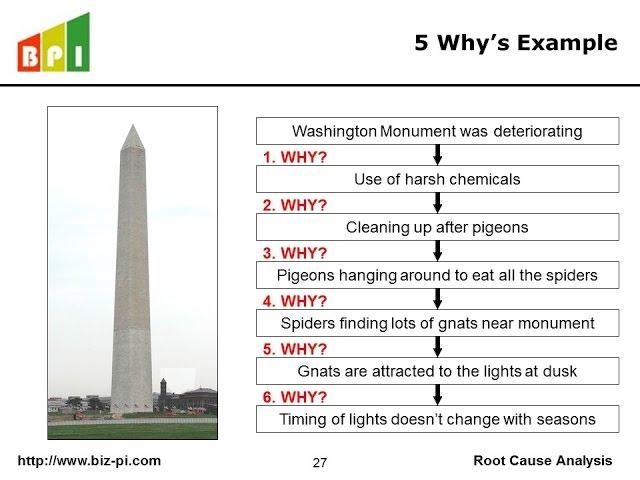
Root Cause Analysis Course - 5 Whys and Fishbone Diagram
Комментарии:

Easy to understand and I truly enjoy your clear voice with no background music. Thank you!
Ответить
Thank you for sharing this sir. Is any file that we can get by mail?🙏🙏🙏
Ответить
Thanks Brion!
Ответить
hello can i have this as my basis for my report
Ответить
Hi,Brion. Great video! Thank you for sharing the course video, it's really help me in doing the RSA.
Ответить
I love consulting subject yeah
Ответить
This is a very useful video - thanks
Ответить
Wow! Been in manufacturing for 25 years an this is the best and uncomplicated video for root cause I've ever seen! Great job at explaining and defining the process!!! 👏👏👏
Ответить
Hi Brion, just want to say thanks so much for sharing this webinar video! Really helps me and my team in doing the RCA!
Ответить
Wonderful!
Ответить
Great material mate!
Ответить
you're just reading the slides , what a great video !!!
Ответить
Wouldn't be the most interesting question why the engineering team didn't had the manufacturing process in mind up front? Without answering this question you can only solve the immediate problem, but not future ones. Could be just a mistake, then that's fine, but could also be that there is no communication/feedback process or information/people sharing between engineering and manufacturing. Or that there weren't appropriate testing procedures.Or that information was missing because of illness and people didn't shared knowledge enough before the illness (truck score bad). Or something completely else. It's a bit funny that this happens exactly when in the example there are less than 5 whys asked. (Isn't it the main principle?)
Ответить
Wt? No!!! Difference is,
SixSigma is a Methodology Approach to Determine Statistical Processes Capability. Lean also uses a Methodology Approach to eliminate Waste Within Your Organization.

It is great improvement EHS course helps to do accident investigation with effectiveness
Ответить
Thank you. I will share this video to my team for review of RCA topic.
Ответить
Very good video. Thanks for sharing!
Ответить
Who is here after their boss asked them to do RCA for particular messed up by you ? :D
Ответить
VERY GOOD
Ответить
Thanks for sharing this video! Solving the root cause problem it's indeed the only way to prevent recurrence! It applies not only in business but on day to day life too!
Ответить
Thanks sir
Ответить
Very helpful and informative video. Kudos to the great work and efforts you poured...Thank you !!!
Ответить
Good job
Ответить
Great Video! I learned a lot, thanks for posting.
Ответить
Thank u.
Ответить
"When?" also includes the LATER issue, "When did the problem happen?" and "Where?" includes the LATER issue of "Where did the problem occur?"
BTW, I'm in the UK, but I always use the Washington Monument example when training 5Y.

"Preventive Action" is NOT the same as a tough Corrective Action. It typically comes from risk analysis or FMEA, and implements action to prevent a problem from ever occurring in the first place. Then you have "Correction" (the knee-jerk inspection/repair kludge) and "Permanent" (the systematic resolution of this kind of problem on this kind of process, or similar processes).
Ответить
You don't touch on the indeterminable risks of loss of customer confidence. Then at trade conferences, they talk to their competitors... A rigorous and fact-driven approach to root cause and permanent corrective action is vital to regaining customer confidence in your service and product.
A long time ago, when I was an aerospace quality engineer, I was detailed to attend a KIP (key inspection point, where the customer attends). I wasn't an antennas engineer, my remit was wiring harnesses and electronics, but basically, this part had been made incorrectly, and this was highly embarrassing. We could do nothing about the wrongly-manufactured part, but as part of the verification, I said I would audit the supplier.
I have to confess, I drove to the audit with blood in my eye. This wasn't my job responsibility, but I was assigned to sort it out.
Now, this wasn't a gleaming steel-and-glass aerospace titan, but a small precision machining company. Nevertheless, it looked a nice place to work. The place was clean and well-lit, and there were plants and pictures. There was also copious quality data, and I was pleasantly surprised to find that when interviewing the machine operators, each of them was aware of the incident, and several had taken part in the RCA/implementation of CA. They also know what the data on the noticeboards meant, their part in it, and the consequences of them deviating from documented processes.
Machinery was immaculate, and process documentation was clearly filled out at each stage. Dig as I might, I could not find any instances of poor practice or systemic weaknesses. Yet I saw absolutely no sign of defensiveness or evasiveness. Everyone was upfront with an immediate answer to the actual question I asked (rather than a defensive reaction to the questions to which they assumed this trail was intended to lead. Equipment was immaculate, with copious calibration, verification and safety records. Operators said exactly what they did, and then pulled out the relevant procedure, which tallied in all respects. This tiny company, which I could thoroughly audit in a day, rivalled the giant aerospace company for which I worked, when it came to QA.
We finally got around to corrective action. The quality manager opened a cupboard (UK English for closet) and pulled out a FAT (sorry, plus-sized) lever arch file. I asked "So our investigation is in there, is it?" and he said, "No, this IS your investigation."
I was frankly stunned that such a small company could do such work in a week. There must have been long nights, early mornings and weekend work in there. I am a FAST reader, but it took me three hours to go through this truly comprehensive analysis. Every single step of this 8D/Fishbone/5Y investigation was supported by facts and data, and the testing to verify the permanency of the CA was as solid as the rock of Gibraltar. They had scrapped a lot of metal in a comprehensive set of tests covering all possible operational modes, removing the fix (which was a lovely, simple, Poka-Yoke), then provoking the fault, then refitting the fix and doing the same without the fault occurring.
After my impassioned presentation to the customer, they said they were in no doubt at all that the comprehensive investigation and effective (and verified) corrected action would mean that this problem could never, ever happen again. I fell into a shit-pool and came out smelling of roses.
I was, to use a classic Britishism, utterly gobsmacked by the supplier's response. This actually had a big effect on me, which, in part, is why I'm now shortly to take on a top-level quality management role in a major multinational defence company. In an earlier job as a quality manager in a telecoms company, I had employed the same quality techniques, which had so grabbed me as a young quality engineer. We had a major customer in the form of a VAST US aerospace company (no, no names, I'm afraid. I could tell you, but then I'd have to kill you.) They had had recurrent issues, caused in large part by issues at the Chinese company that assembled our products. The first time they came over to our company in the UK, I dropped eight fat dossiers on the table. They were used to single-page stuff from my predecessor, and looked a little nonplussed.
Each one addressed two root causes: 1) How did the problem happen? and 2) How did it escape through the current controls?
Again, having ploughed through the lengthy reports, the customer reps looked much happier. And those problems never happened again, and the number of problems dwindled down to zero and stayed there.
There have been numerous occasions in my quality career where a robust response to quality issues has garnered more good humour in the customer than never having a problem at all. Indeed, one customer, an installer, obviously concerned because of his prestigious and important customer, screamed down the phone to me about "The fu*&ing sh$t you fu*&ing sold us". I visited the installation, and the equipment had been uninstalled incorrectly. Some quality managers might have breathed a sigh of relief, and thrown it back to the customer, but I realised we'd probably have lost a big customer. The problem was that the installation was heavily unbalanced, and the correct balance was detailed in the product manual. However, I realised we could probably redesign the product to handle even this level of imbalance, and then the contractor wouldn't have to completely rebuild the system, just replace a drop-in unit. The Design Manager and I spent many, many late nights and evenings redesigning the unit, starting with the parameters we would need to achieve, and how we might optimise the product to achieve this.
I demonstrated it to the same rep from our customer company, and the end user, again, showing that the mod handled this imbalance with ease, whereas the old unit failed every time. I thought the formerly foul-mouthed customer rep was going to shake my right hand off, "Oh, thank you, thank you..." He took the boss, me and the design manager out to the five-star Claridges Hotel in Mayfair, London, where I had a fantastic dinner, though I can only remember that it started with whipped cod's roe and vegetables, due to the copious amount of brandy we downed. I did tell him about the imbalanced installation, and his eyes welled over. Again, the mighty hand-crush and vigorous shake.
We stayed there for Friday night and were taken home by limo the next day. OK, it might be considered conflict of interest these days, but if the boss was OK with it, I wasn't about to refuse. The customer rep sent me a Christmas card every year until just a few years ago when he moved to the States.
But there was now another bonus: we had a better product, better than any other on the market for a similar product, and it didn't cost any more to build than its predecessor. I let the sales team take that on...

fish bone should be called Ishicowaw diagram in honour of the man who inventerd it (Sorry for bad spelling)
Ответить
thanks
Ответить
Thanks for sharing very informative for school assignments and work assignments.
Ответить
Fish bone ko Hindi me
Ответить
Thank you so much
Ответить
there is no time to implement all that, there is no willingness to participate on that, there is just a need to meet production-daily quota.
Ответить
Hello Brian, I have a question about the definition about the core of the problem to work. Normally the leadership and manager have some idea about where that accident come from and they trying to transfer the problem to other department . How to convince them to be impartial on it?
Ответить
Thanks Brion for a very informative video, I have a question about the process time duration, How long should the team run RCA (or 8D) to make the entire process efficient?
Ответить
Great ovrview, thanks for posting this!
Ответить
Great Video; Good examples.
Ответить
Great overview!
Ответить

























